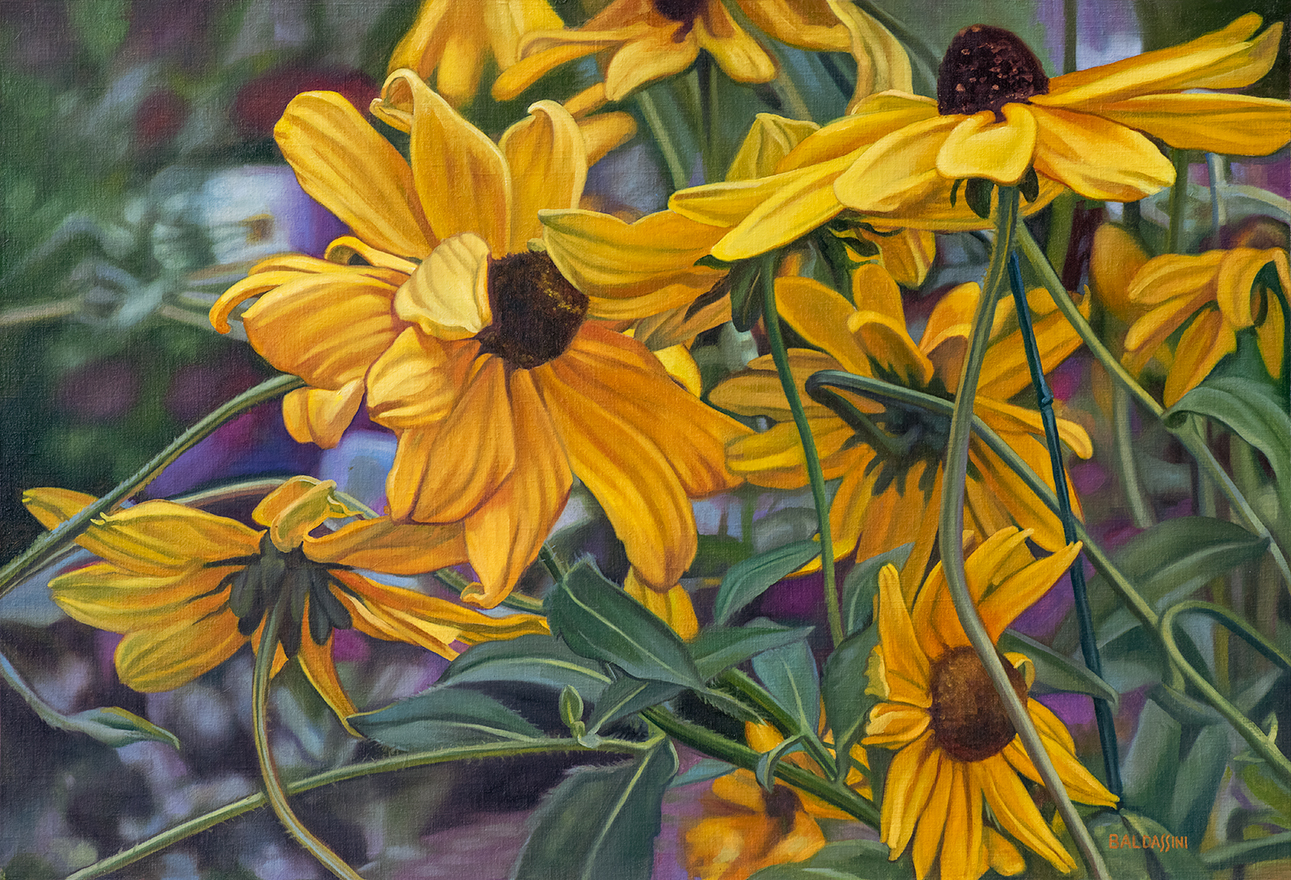Coneflowers – Oil on mounted portrait linen panel, 24.25 x 36 inches unframed.
For more than a decade now I had been painting floral compositions in oil in large format (24 x 36 average). My process was always the same:
- Photograph flowers – mostly peonies and roses – in their natural settings,
usually public gardens like Elizabeth Park in West Hartford, CT or local private gardens.
- Download the images to my computer – average 180 images per session — and view
and evaluate them onscreen.
- Choose, edit and composite the images that would make the most interesting composition.
- Produce a 12 x 18 inch color print for visual reference and a grayscale digital
copy for tracing or projection onto a mounted linen panel that I prepared myself weeks ago.
- Execute a drawing by tracing or projection using a silverpoint tool.
- Create and underpainting using Raw Umber.
- Complete an overpainting using a 24-color palette over a period of three to six weeks.
- Varnish after waiting three to six weeks to dry.
- Have the work professionally framed.
- Package and ship to gallery.
And so it went for ten years or so. I had the good fortune to gain representation by a nationally recognized gallery in Cape Cod, MA where most all of the work hung in that gallery was sold, usually in short order. Twenty-four works over a period of eight years. Then beginning in late 2019, right before the Covid-19 Pandemic the sales stopped – completely. I kept painting of course, but not a single work was sold for more than three years until one last work was sold in October, 2022. It became clear to me that I could no longer continue to paint florals, at least the photo-realistic style I was panting them in. Since the Pandemic, the cost of art materials, like everything else, had risen dramatically, as had framing, packaging and shipping.
It wasn’t until I had I created a spread sheet listing the line item costs that factor into the creation of one of my standard size floral oil paintings, including the labor to build the panels and actually paint the work, and then package and ship it that I realized I had to move on from painting floral compositions.
It takes about 80 hours labor to produce one my standard size works from start to finish, including photography, design and composition, panel preparation, drawing, under- and overpainting, varnishing, packaging and shipping. That time plus all of the associated material costs, minus the standard gallery 50% commission fee averaged out to almost exactly $18 per hour – little more than minimum wage. I encourage every artist to do this to really get a handle on their productivity and expenses.
Despite my best efforts to get those works into several galleries, no sales were generated for almost 4 years. To continue fronting those expenses along with the investment of time, with no return on sales had simply become untenable. The well-known aphorism, “The definition of ‘insanity’ is doing the same thing over and over again and expecting different results”, often credited to Albert Einstein although there’s little to no evidence Einstein did ever say this, certainly applied to my current situation.
A change was necessary so the gallery manager and I amicably parted ways. I never really understood why my paintings were no longer viable except that “realistic artwork was no longer selling”, according to the gallery manager. Fortunately, I did not rely on gallery sales to earn my living. The sales from paintings were part of an income stream mix, most of which came from my Photo Restoration business of more than 35 years, and other monthly benefits. To be “successful” as a painter, allowing one to paint full-time and derive enough income to pay the bills and put food on the table, let alone occasionally purchase a new pair of shoes, see a movie or play, take a vacation, put a child through college, and save for retirement and old age is nearly impossible, even with gallery representation. It is a very difficult road to travel on and a poor career choice. I think that most painters are just barely able to survive and nearly all maintain a source of income from other jobs.
I still love to paint and will continue to do so. I have always had an interest in landscape, particularly fields, pastures, tree lines and copses. There is certainly a lot of that around where I live in Connecticut, all of which I have been observing, photographing and assimilating for a great many years, almost as long as long as I have been painting florals. Going forward I will change everything up. For example, to paint new works I will now use only inexpensive large brushes where previously I used expensive small brushes. Instead of a 24 color palette, I will use no more than 6 colors on any painting. And, instead of looking down to photograph flowers, I will be “looking up” at the fields, sky and clouds, and most of all the light – the source of all that makes us alive and human.

3 Responses
Excellent post, dad! I’m so proud of all that you’ve accomplished and excited for what’s to come!
Very interesting points you have remarked, regards for posting..
Thank you Vida T. -P